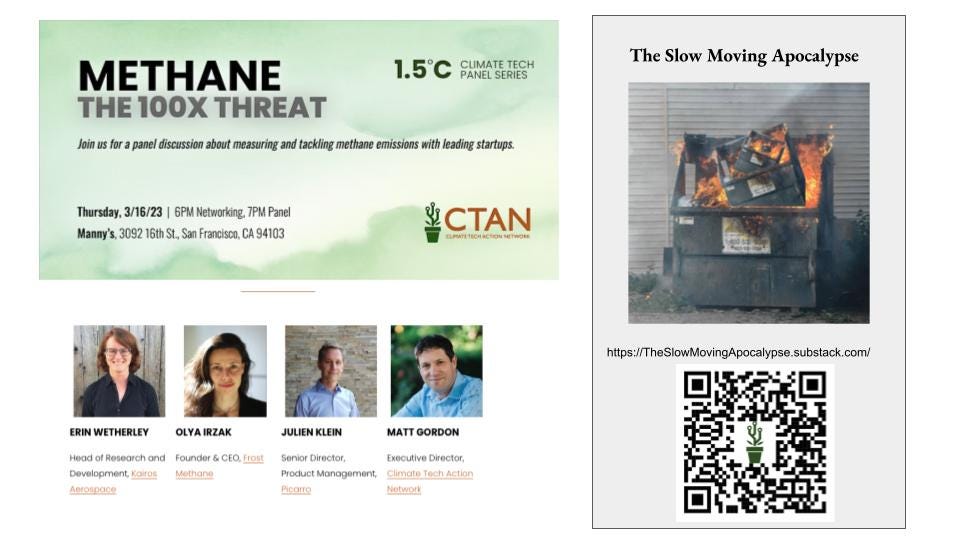Methane and Global Warming Potential
Methane is bad for climate change, but there are things we can do about it
We had an amazing panel event last night, featuring several august panelists discussing various aspects of methane emissions and mitigation across the energy, utility, and agriculture sectors.
It was really energetic and we had a lot of great questions. But I am exhausted! So this week, I am going to share some of the highlights from the event with you.
We’ll be posting the video to our website soon, but if you’re really eager to see it, you can view the raw video here:
You can also see my introductory slides from the event here:
One of the topics we discussed was the Global Warming Potential (GWP) of methane. The EPA defines GWP as follows:
The Global Warming Potential (GWP) was developed to allow comparisons of the global warming impacts of different gases. Specifically, it is a measure of how much energy the emissions of 1 ton of a gas will absorb over a given period of time, relative to the emissions of 1 ton of carbon dioxide (CO2). The larger the GWP, the more that a given gas warms the Earth compared to CO2 over that time period.
For methane, the GWP is often stated as 20 - 100, meaning methane has 20 - 100 times the “climate forcing” relative to carbon dioxide. Why is there such a large range? The reason is that methane is a much more potent greenhouse gas, but it is more chemically reactive than CO₂ , and so it degrades much more quickly than CO₂. To first order, methane stays in the atmosphere for only about a decade, whereas CO₂ sticks around for hundreds of years.
Because of the time dependence of GWP, some scientists have argued that GWP is actually a really bad way to measure things. It’s easy to understand, but because it is such a bad approximation, it can cause people to come to wrong conclusions if you rely on it too heavily1. If you really want to geek out on this topic, I recommend reading The Global Warming Potential Misrepresents the Physics of Global Warming Thereby Misleading Policy Makers by Bob Kleinberg, who has been thinking about this issue for a long time.
One of the major uses of natural gas in the energy economy is for “peaker plants”, which help balance the load on the electrical grid by providing surge capability during peak energy usage periods, like heat waves and cold snaps. Ironically, one of the most important roles for peaker plants is to smooth out the inherent diurnal fluctuations of wind and solar (on during the day, off during the night). But as new forms of energy storage become more cost effective, we will be able to move away from natural gas and rely solely on renewables.
So, the important facts to remember are:
Methane = very very bad for global warming
There are lots of things we can do right now to reduce the amount of methane getting into the atmosphere
Aside from the whole Fox News-generated brouhaha over gas stoves, we are not going to reach net zero carbon until we de-carbonize the energy sector, and that means that, in the long run, we’re going to have to get rid of natural gas as an energy source.
This fact is one of the central themes of Seeing Like a State, which I have been working my way through recently: governments need simple metrics to help decision-makers, and often choose ones that are easy to understand, at the expense of accuracy and completeness. In the worst cases, they design entire social plans around oversimplified metrics, and then steamroll over their constituents, because things like happiness and community and beauty and diversity are not well captured by metrics like GDP, for instance.





